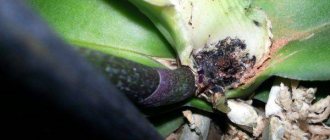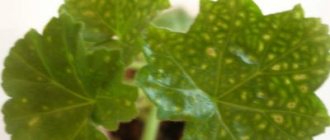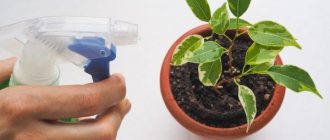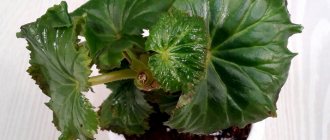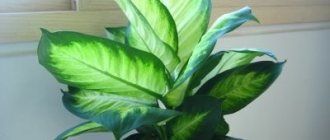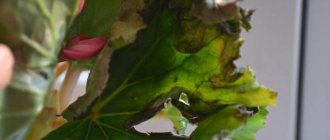This decorative flower comes from Africa. On its meter-long leaves-stems there are paired dark green leaves that are leathery to the touch. With proper care, the flower has enviable immunity and therefore rarely gets sick. But in people who do not have experience in cultivating plants, it can hurt:
Dear readers! For you, we have created communities on social networks in which useful articles and interesting ideas are published several times a day! Subscribe and receive useful content in a convenient format!
- Viral diseases;
- Microbial diseases;
- Damaged by pests.
Zamioculcas is not a whimsical plant, and the main thing for the gardener is not to harm it with excessive attention.
What diseases affect Dollar Tree?
Sometimes with a newly brought flower you can introduce a fungal disease into your collection. Experienced flower growers recommend quarantining newcomers for 2 weeks, and then it will be clear whether he is infected or not.
Anthracnose
A fungal disease that attacks the leaves and stems of a plant.
Black and brown spots appear on them and grow over time. Most often, this fungus appears in greenhouse conditions , when the room is warm and humid.
This disease is not difficult to survive cold weather and therefore, in order to completely get rid of it, the plant must be treated with fungicides:
- Bordeaux mixture;
- Colloidal sulfur;
- Copper kuparos.
Powdery mildew
Powdery mildew appears in the warm season plus increased watering.
It is easy to notice by the coating on the plant, it looks like flour.
When the disease occurs, the affected leaf blades become covered with a powdery coating and die off after a while. Therefore, treatment begins with:
- Topaz;
- Speed
Sooty (black) fungi
The manifestation of the disease is a sooty black coating on the plant. Appears due to the sticky secretions of such pests:
- Aphid;
- Whitefly;
- Mealybug.
First of all, you need to get rid of harmful insects, and only then get rid of the sooty fungus itself. Zamioculcas can be washed with laundry soap after treatment. If this does not help, then treat with phytosporin.
Leaf burns
Burns to leaf blades cannot be treated.
The affected leaf remains damaged.
It’s just that in the summer, when the sun’s rays behave noticeably more aggressively, the zamioculcas is removed from the south window and moved to the north window, or if there is none, then deeper into the room.
Rotten
To get rid of rotting places on a flower, you need to remove it from the soil, get rid of all affected areas and treat it with appropriate fungicides. The pot is doused with boiling water, and new soil is purchased. When cultivating this flower further, you must carefully monitor its watering and not overwater it.
Important! You need to periodically inspect your pets for pests, otherwise the plant may not be saved. Therefore, in the initial stage, the lesion is easier to treat than when the entire flower is completely affected.
Dark spots
Just darkened areas on the trunk are natural. But if stripes and traces of rot also appear, then the flower needs to be treated.
The first signs of rotting of the zamioculcas stem appear in the form of brown spots.
The plant is treated with disinfectants , and the soil in the flowerpot is changed to fresh and sterile .
Problems with Zamioculcas leaves
Sometimes, due to improper maintenance, various diseases appear. The trunk darkens in spots or the leaf blades turn yellow. This is a consequence of two main mistakes: the gardener dries out his flower, using too infrequent watering, or the flower is flooded, often using too cold water.
Turn yellow
If this slight yellowing is not more than 5% of the total leaf mass, then this is natural aging of the leaves.
It’s worse if the entire meter-long branch turns yellow at once. This indicates improper care or pest infestation. Therefore, it is necessary to reconsider the irrigation regime and water quality.
If everything is in order, the flower is inspected for the presence of pests and if they are found, they immediately begin to treat it with the necessary drugs.
Wither
Leaf blades can wither due to natural aging, and this only happens to the lower leaf blades.
If the entire branch dries out, then this is mechanical damage or errors in the watering and lighting modes.
If this occurs with the simultaneous appearance of black spots, then this is a sure sign of root rotting from overwatering the plant and watering with cold water.
Important! Follow watering rules.
Stains
Dark spots are a manifestation of improper care due to excessive watering of the plant. Leaf blades with black spots are removed, the plant is pulled out of the ground and the root system is examined. If rotting places are found on it, then they are cut out to healthy flesh, treated with wood ash and the zamioculcas is planted in new soil. In this case, it is worth reducing the frequency of watering.- Brown blotches on the leaves appear in the cold season from being kept in a place where there are cold drafts. To prevent new blots from appearing, the flower is moved to a warm place without drafts.
- Black spots on the stems are a consequence of overwatering or indicate that some of the roots have died. It is necessary to organize proper care for Zamioculcas.
Sticky spots on leaves
Sticky leaf plates appear at the moment when the flower is affected by harmful insects. Since stickiness is a product of their vital activity. Feeding on the sap of the plant, they secrete a sticky mass, and sooty fungus often appears, since its spores easily stick to such foliage.
Important! Therefore, when such leaf plates are detected, it is necessary to urgently find the pest and begin treating the flower.
Drying leaves
With rare exceptions, this process is completely natural - first the lower leaves of the flower die, then they turn yellow and fall off the trunk. If young leaves that have just appeared fall off, look for the reason in violation of the rules of care. They are typical - low temperature, drafts and stagnation of water in the flowerpot.
The falling of young leaves is an alarm bell. To prevent the disease from developing, it is better to immediately transplant the plant into a new pot before rot destroys it.
Problems with roots
If the watering regime is improperly organized, Zamioculcas may experience problems with the root mass.
Drying
If the root system of a plant that is adapted to live in the desert dries out, this means that the grower has not watered the plant for six months. Because the root system of Zamioculcas is capable of accumulating in its potatoes the water necessary to nourish its own bush. Therefore, it is necessary to organize a watering regime. If the roots die immediately, they can be grown again.
Rotting
This is the same bay of the plant.
He urgently needs a transplant with the simultaneous removal of all rotting parts. In this case, the land must be purchased, since garden soil is too rich for this flower.
Land for desert cacti will suit him. After processing and planting in new soil, watering begins 15 days later. In this case, the water should be warm and settled. Zamioculcas fertilization begins a month after planting.
Black
If these are not rotting roots, since the watering regime was followed, then most likely these are just adult (old) roots of Zamioculcas. If they have white growing tips, then these are healthy roots.
Spots on the roots
Spots on the root system indicate that the flower is given too frequent watering. In this case, cold water is used. To correct this situation, water with warm water and at least 2 times less often than the previous regime.
Pests on the roots
Harmful insects come either from contaminated soil or brought from the store with another purchased flower. Therefore, the new recruit is usually quarantined 2 weeks away from the main array of flowers in the house.
If a pest is found on yellowing foliage, the flower is removed further from other plants and treatment begins.
Important! If a pest is noticed in time, you can get rid of it quite quickly, so it is recommended to inspect the flower from time to time for their presence.
Mealybug
Leaf plates can become deformed due to the appearance of mealybugs on them.
This harmful insect lives and breeds on the leaves of Zamioculcas. It is easy to detect because it secretes a sticky white cotton wool as it feeds on the sap of the plant.
Its harmful effect on the plant is not only that they feed on its sap, but also its secretions on the leaf blades block the access of oxygen and the affected leaves do not participate in photosynthesis.
To get rid of scale insects, wash the flower with 72% laundry soap, and if this does not help, treat it with one of these preparations, diluting them according to the instructions indicated on the package:
- Aktellik;
- Phytoyerm;
- Intavir.
Thrips
The fact that thrips have appeared on the plant will be indicated by a white coating on the leaves and twisted shoots.
The flower must be placed at a safe distance from other indoor plants and its treatment must be started using the following preparations:
- Karbafos;
- Intavir.
Important! When processing plants, you must adhere to safety rules so as not to cause poisoning to children and pets.
Ticks
This pest is easy to detect on the green mass of the plant - it is small, up to 1 mm long. a red spider that forms a web on the outside of the leaf blade.
It is removed mechanically by wiping the leaf plates with a cotton swab soaked in alcohol.
In hard-to-reach places, use an ear stick to remove cobwebs. Then they are treated with Aktara or Aktellik. The action must be repeated twice with an interval of 5-6 days. This is the time during which the tick larvae begin to hatch from the eggs.
If it is not possible to treat chemically, then you can use a folk remedy and treat the plant bush with green soap purchased at the pharmacy. The treatment is carried out until the pest disappears.
Shields
This pest is easy to see on the leaves of the flower as it reaches a length of up to 4 mm.
and it is brown in color. The shell is easily removed with a fingernail, but underneath there are many larvae that feed on the sap of the plant. And then black spots appear on the leaves and they dry out.
Before processing a plant, you must first remove all shells mechanically and then proceed to chemical processing. The shells are removed manually, since the chemicals do not fully penetrate under them, and the surviving larvae will build a new shell for themselves and begin to reproduce again. Preparations that can rid a flower of this pest:
- Actellik - it is treated three times with an interval of 6-7 days.
Parasitic insects
Even at home, dollar trees can become infested with insect pests. Small midges enter the house along with new purchased plants or through open windows in the summer.
A frequent uninvited guest on indoor flowers is a small black midge. In damp conditions, small black midges multiply very quickly and live on leaves and on the surface of the ground. The first thing to do is to stop flooding the plant too often and too much . If a dollar tree gets sick as a result of an insect attack, it will have to be dug out of the flowerpot and dried for a couple of hours. After drying, the flower is planted in fresh soil. At this time, the room is well ventilated.
After transplantation, you should not water the diseased flower for the first few days . We need to watch to see if the midges appear again. Watering after transplantation should be done only through a tray .
Aphid
Aphids often appear on zamioculcas if the flower is taken outside in the summer.
Such an omnivorous pest as aphids does not bypass this flower either.
The small pest multiplies very quickly and sucks the juice from all parts of the plants. If the aphid invasion is not stopped in time, it can destroy even an adult, strong flower in a short time.
Against aphids, it is necessary to spray the dollar plant with drugs such as Decis or Intavir . Among the folk remedies against aphids, infusions of marigolds, tansy or dandelion help well.
Shchitovka
Another reason for the appearance of dark spots is an attack on the flower by scale insects.
To cure a plant, insects must be collected very carefully by hand, and then treated with a fungicide.
How to reanimate Zamioculcas?
What if the plant's tuber rots?
In this case, we take out everything that is left of the flower and clean it to a healthy place. From the remains we grow a new flower. If there is at least some root growth, we plant it immediately in new soil; if there are only leaves left, we put them in water to grow roots.
If the leaves curl?
Deformation of the leaves indicates that the flower is affected by harmful insects. In this case, the zamioculcas must be carefully examined and, having found them, get rid of the pests with a suitable preparation.
What if the leaves of the plant are frostbitten during transportation?
This is the easiest case of what can happen to Zamioculcas. Since the root system in this case is completely healthy, the frostbitten leaves are cut off at the root, and after a while the roots begin to produce new healthy leaves.
Care Tips
After any, even minor treatment with insecticides, you need to protect the soil by covering it with film. The next day, when washing off the chemicals with water, you should protect the plant from getting them under the root - cover the soil again.
And finally, we repeat - the zamioculcas flower is extremely resistant to pests and infections when it is healthy. It is enough to provide the plant with normal water drainage, correct temperature and light conditions, take it out into the fresh air in the summer, and it will reward you with its beauty and health.
Fungicides for Zamioculcas
Zamioculcas can be treated with the following drugs:
- Maxim - helps with red burns and various manifestations of rot;
- Fitosporin against fungi at the initial stage of infection;
- Fundazol – it kills various fungal spores;
- Hom – helps against brown spot and various bacterial diseases;
- Quinozol is an antibacterial chemical;
From a variety of drugs, only one is selected and the plant is treated with it according to the instructions.
Common mistakes
With improper care, errors occur, and in order for the plant not to die, you must try to correct them in time.
| Care error | Correction method |
| Reduced room temperature and simultaneous flooding of plants | If there are young shoots, then you don’t have to worry, just move them to a warm room and adjust the watering. If the flower does not grow, then it is removed from the soil and the roots are treated from rotting places. |
| High air humidity. | Droplets of water appear along the edges of the leaves; the plant seems to be crying. All aroids react this way to a prolonged rainy period; you don’t have to do anything special. |
| Pot too big. | The plant does not increase its green mass, since it needs to reduce the container in which it grows. |
Slow and defective development
If the plant begins to lose weight and stretch, the foliage turns pale and the number of segments on the young plants decreases, then most likely the reason is insufficient lighting. It is necessary to reconsider the conditions of maintenance and place the flowerpot closer to the sun, and if this is not possible, it is worth illuminating the tree artificially. You need to purchase a special lamp for plants that emits a spectrum as close as possible to the sun. Ordinary household lamps will not give the effect - they are not suitable.
Zamioculcas, in general, is not characterized by rapid growth, and if it slows down even more, look for the reason in the lack of space for roots - perhaps you need to transplant the plant into a larger flowerpot. Another reason for this behavior is a lack of microelements. Try adding complex formulations containing potassium, magnesium and nitrogen. The tree reacts especially sharply to nitrogen deficiency.
Answers to frequently asked questions
Why do Zamioculcas leaves turn yellow and fall off in winter?
When it gets very cold indoors, the flower begins to turn yellow its leaves. If this does not happen en masse, then there is nothing to worry about. If the central heating radiators make the house too hot and dry, then you need to spray the flower with a spray bottle.
Why do the plant's stems lie horizontal to the ground?
This comes from overwatering. The plant is oversaturated with moisture and the stems bend under its weight. Seeing this, it is urgent to reduce watering.
Why doesn't the plant produce new shoots?
In Zamioculcas shoot growth is very slow and therefore two shoots per year is the norm. The main requirement for active growth is a tight pot plus fertilizing with a high nitrogen content.
Why does the stem wrinkle?
A common cause of this is also overwatering. Since some of the roots have been lost, the remaining ones cannot feed the leaves and therefore, from lack of nutrition, the stems begin to wrinkle.
How often do you water zamioculcas at different times of the year?
When thinking about the watering regime, we must remember that this is a desert plant and it does not need a swamp at all. Therefore, provided that the flower grows in a cramped pot, water it no more than once a week in summer, and once a month in winter.
First watering after resuscitation and transplantation
After resuscitation has taken place, the roots remain in the air for 2 hours in order for all the wounds on the tubers to heal. After that, planting is carried out in new correct soil, and Zamioculcas begins to be watered a month later.
What to do with the plant after purchasing it?
First of all, all new plants are quarantined for two weeks. This time will give us confidence that the plant does not contain various types of pests and diseases. After this, the flower needs a transplant.
The container is 3 cm larger than the previous one and the soil intended for cultivating desert cacti. After the flower is transplanted, do not water it for up to 3-4 weeks. This will help it adapt to the new container and not rot.
What to do if a branch breaks?
Do not rush to throw away a zamioculcas branch if it breaks . This is an excellent breeding material. A long branch is cut into several pieces 8-10 cm long. Then these cuttings are stuck into moist soil in which the amount of sand exceeds the substrate by 50%. Water once a week.
On a note! Zamioculcas grows for a very long time. Therefore, it will take a long time for the cuttings to germinate and take root. As a result, you will get a new plant that is well adapted to home conditions.

